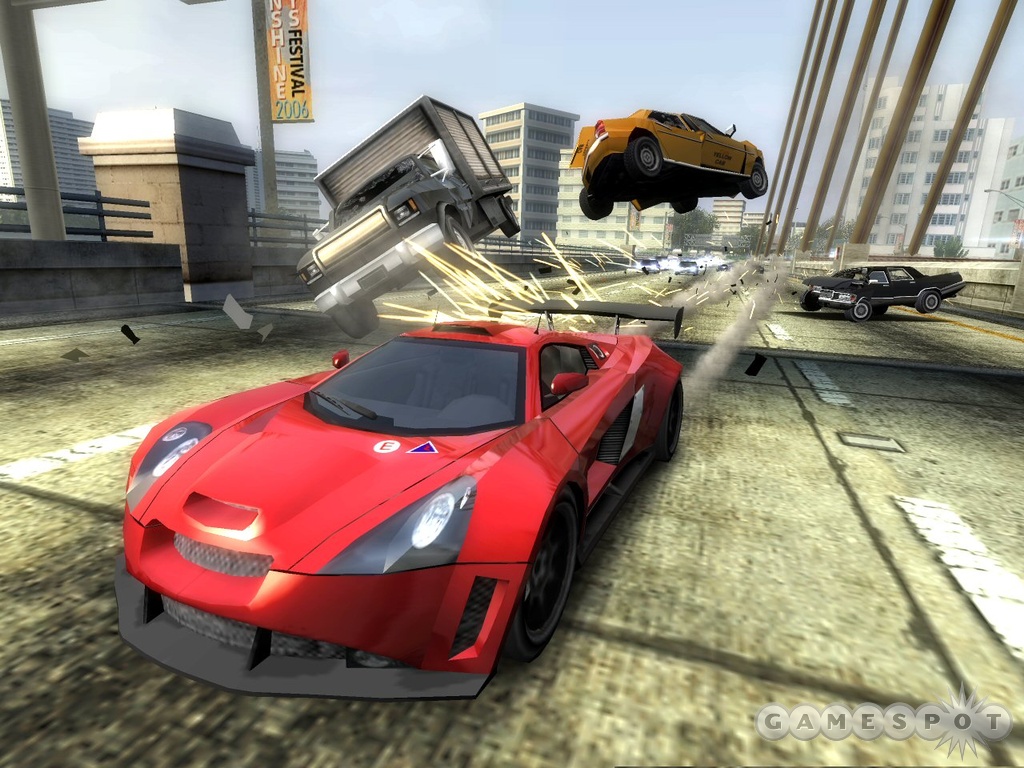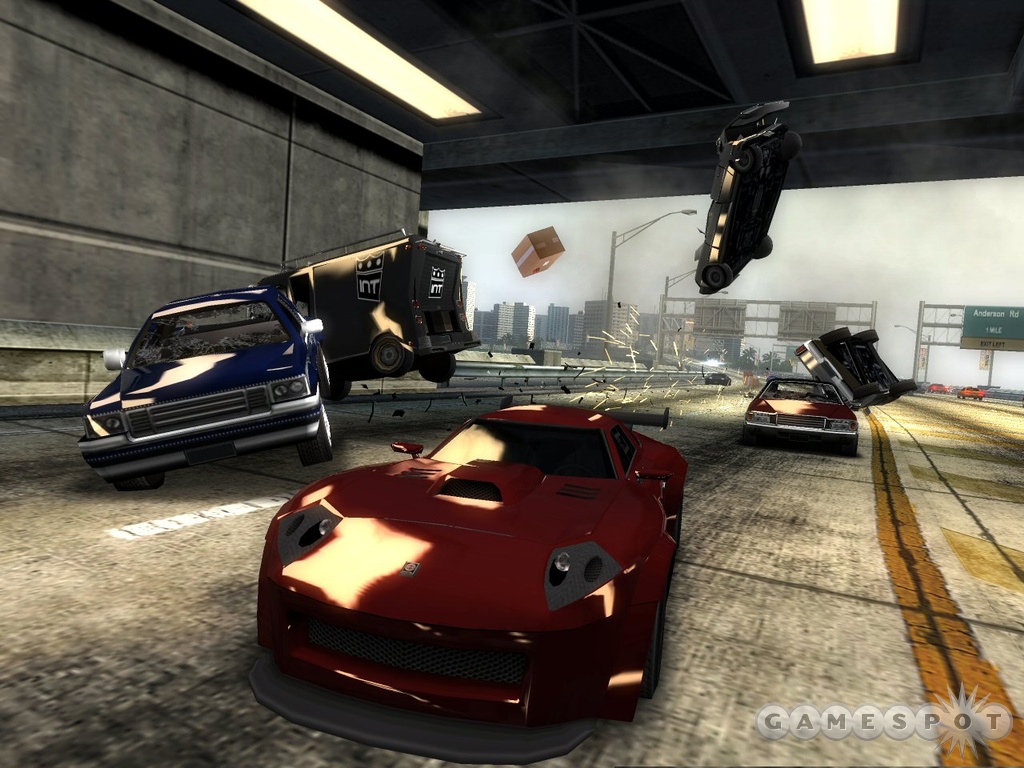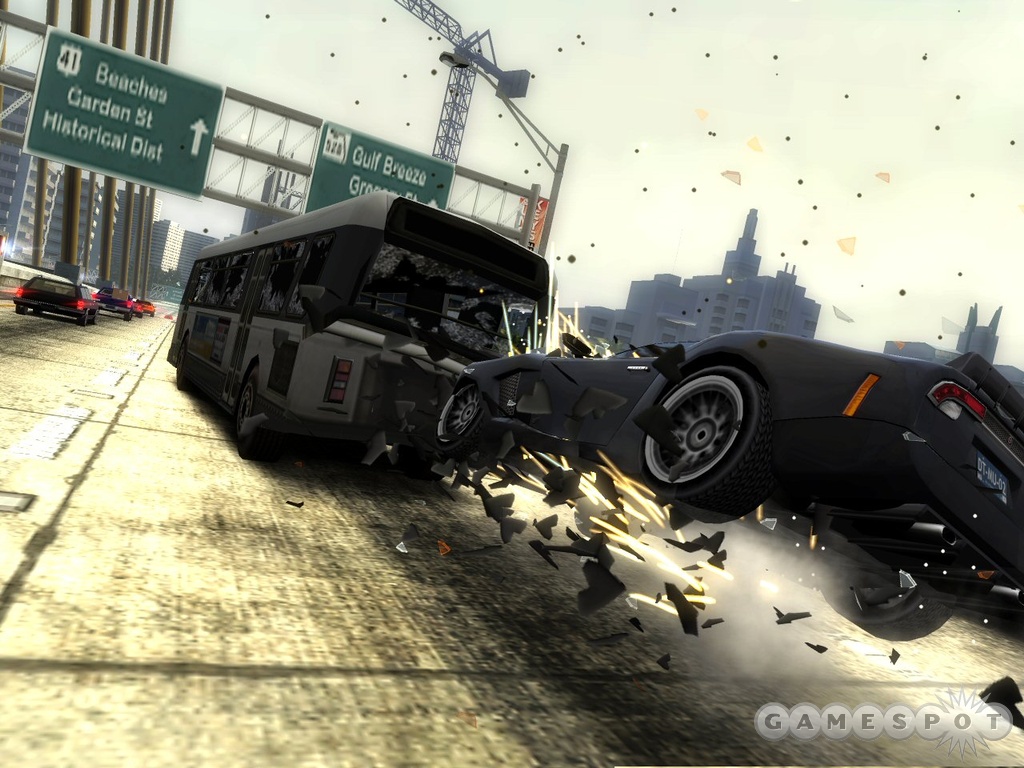Burnout Revenge Designer Diary #2
Matt Webster, executive producer of Burnout Revenge, discusses track design and rush-hour traffic.
It would have been easy for UK-based Criterion to create a sequel to Burnout 3: Takedown that simply offered more of the same great gameplay that had earned that game a GameSpot Editor's Choice Award last year. That's not how Criterion works, though, as executive producer Matt Webster alludes to in his latest designer diary on the subjects of Burnout Revenge track design and traffic.
Built to Battle
By Matt Webster
Executive Producer
Burnout has a number of guiding principles that define what the player's experience is. It's about speed, crashing, traffic, accessibility, and, of course, aggression. We didn't want to mess with any of these--we wanted to pull them into the new game even further than we had done before.

First of all, we started by looking at the tracks. With aggressive driving being core to Burnout, we realized that actually, none of the tracks that you raced on supported this concept. Our B3 tracks were beautiful. The tracks had an amazing flow, but they didn't really reinforce the concept of aggression, of fighting with your rivals. There was one moment on one course in Burnout 3, Downtown, that did this: Racing under the El in this track, with your rivals fighting you, you knew that one false move would get you taken out into one of the support pillars. That was the feeling that we were after.
We defined a set of design parameters that would guide our decisions for track design. We wanted big jumps, shortcuts, and alternate routes. We wanted areas to encourage battling and fighting. We wanted to expose more of the world to the player so that they can see areas where they can slam their rival to score a takedown. We came up with the concept of choke points, where we would narrow the track down so that the player would have to fight to get through; and of course, we wanted to introduce the vertical takedown! Fundamentally, we wanted the world to mean more to the player.
This meant real changes to the way that we designed tracks. It meant that a lot of the "revenge layer," as we called it, needed synchronizing with the location that the track was set in. We didn't want these elements to be separate to the world--they had to feel like they fitted in seamlessly. Additionally, we decided to really change the art direction within the game. Burnout was always influenced by classic arcade driving experiences, and the art style reflected that. This time around, we wanted to bring it more up to date, to allow the game to grow up visually; and it's a testament to the art team and the art direction as a whole that we were able to do all of this within the timeline that we gave ourselves!
Our next challenge was to update the gameplay to better take advantage of our new take on track design.
Simple Addition, Massive Impact

Next up, we looked at how traffic could have a larger impact on gameplay. Traffic patterns have always been important to Burnout, and we spend a significant amount of effort making it right. Traffic is clearly designed to be a part of our world and is tweaked and tuned to give the player challenges while they are racing. An indication that we get this right is the fact that people don't really talk about our traffic; but it's so important, as it drives the near-miss feelings and, of course, the crashes.
The concept of better using traffic arose out of one of our early brainstorming sessions. We came up with the concept of "checking" traffic (think Ice Hockey) to really make the experience more aggressive, intense, and interactive. But messing with the traffic dynamics in such a fundamental way was scary.
The idea was that we could use same-way traffic as a weapon. You could slam or shunt it to either score a direct hit or to cause a wreck for those behind you to get caught up in. The first step was to prototype this idea to get a feel for how it might work. Interestingly, our first attempt didn't quite work, and we thought that it would become a secondary feature at best. But some of the team got together, worked it up a little more, and then wrapped it up into the traffic attack game mode. It hooked, big-time! We knew inside of a couple of hours that we were on to something. A white board was brought out, high scores were recorded, and a brand-new game mode was born! Traffic attack and checking traffic were now integral parts of the game.
Actually, it's fun to look at checking traffic on its own. When we first started playing and talking about it, we knew that it would be something that Burnout players would need to adapt to. Think about how hard-wired your brain is to dodge traffic in racing games... Checking traffic really changes everything. It quickly made the experience even more accessible for newcomers, while adding a whole new set of challenges for hardcore Burnout fans.
We knew that the overall concept of the game mode was compelling--"Take Your Revenge on Rush Hour"--but we weren't about to add a new game mode for the sake of adding something new. If it wasn't a worthwhile addition to the franchise, it wasn't going into the game. Case closed.
The balancing and tuning of the physics side of this feature took some time, as did work on the traffic attack game mode. Carefully designing the traffic that appears in each of these events and setting the medal thresholds and targets were vital to determine the player experience.

Finally, as the mode was starting to shape up, we realized that we needed to work harder on communicating with the player. For example, we noticed that people weren't using traffic to take out oncoming traffic, buses, and semi trucks. This led us to introduce skill shots and trick shots, which both encouraged players to explore the new features and allowed us to better reward their accomplishments.
We want to make sure you are experiencing all the content that we built into the game. Making sure you understand it is our responsibility...especially with new modes like traffic attack and completely reinvented modes (like crash!), which we'll talk about in detail next time.
Got a news tip or want to contact us directly? Email news@gamespot.com
Join the conversation